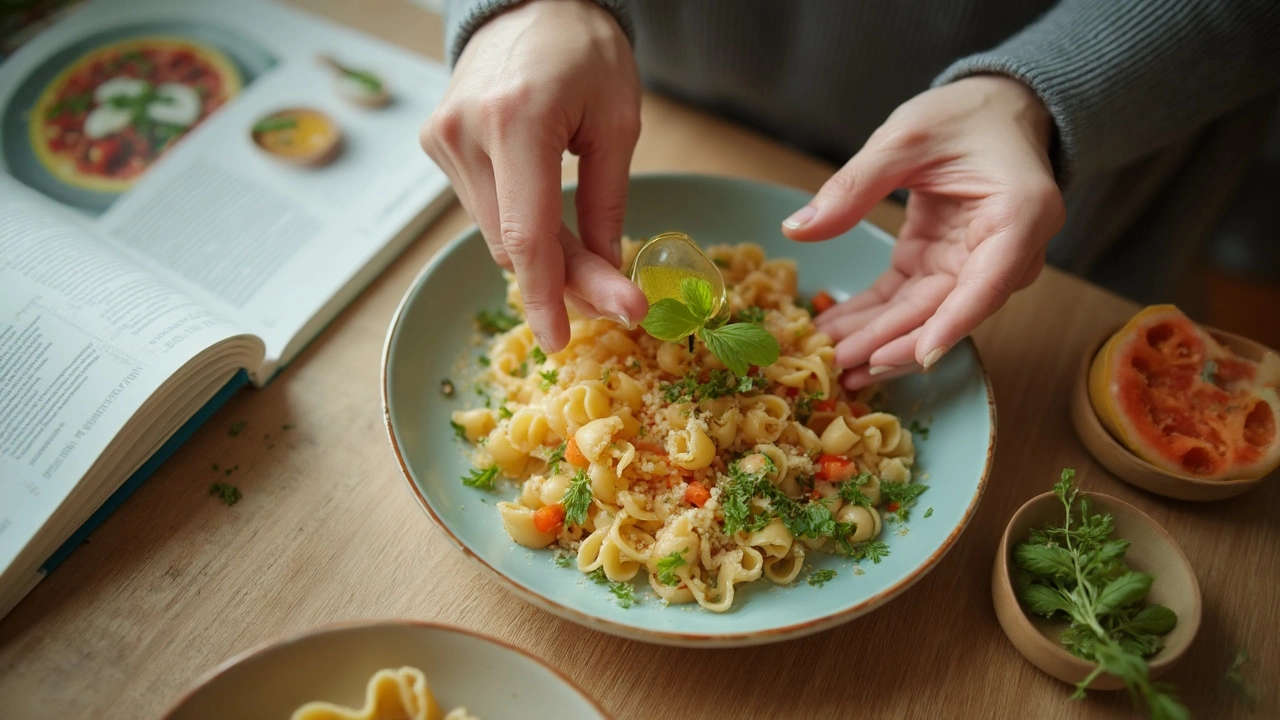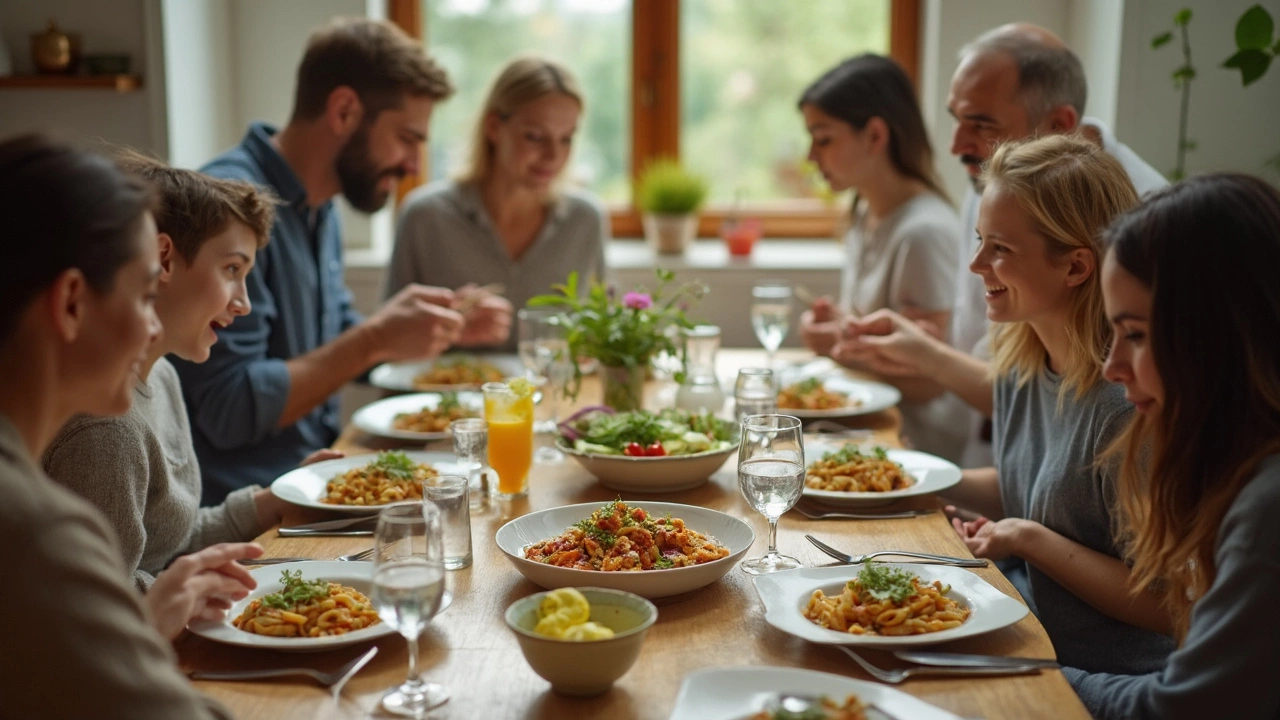Ask anyone who’s visited Italy—pasta’s everywhere. It shows up at lunch, at dinner, in tiny villages and big cities. Yet Italians, on average, are slimmer than folks in the US or UK. So what’s going on here? Are Italians blessed with magic metabolism? Not really. The secret is what, and how, they eat.
If you’re imagining heaping bowls of fettuccine, think again. The average Italian serving of pasta fits easily in your hand, about 80-100 grams (that’s dry weight—cooked it’s still not a mountain). They eat pasta slowly, take their time, and rarely go back for seconds. That’s a game-changer if you’re used to oversized restaurant plates elsewhere.
Italians don’t swamp their pasta in creamy sauces or piles of cheese, either. You’ll usually find light, tomato-based sauces or olive oil, some veggies, and a little cheese sprinkled on top. This keeps the calorie count down but flavor way up.
Want to enjoy pasta and stay healthy? Focus on good ingredients and sensible portions, just like Italians do. It’s not about banning pasta, it’s about enjoying it the smart way. And that’s something anyone can start doing, right at home.
- Portion Control: The Real Italian Way
- Quality Over Quantity: Ingredients Matter
- Pasta's Place in the Mediterranean Lifestyle
- How to Enjoy Pasta Like an Italian at Home
Portion Control: The Real Italian Way
Ever notice how Italians can eat pasta almost every day and still look pretty healthy? A big reason is portion size—not magic. In Italy, the average adult serving of dry pasta is around 80 to 100 grams (about three to three-and-a-half ounces). For reference, that’s a single, level handful before cooking. In many American or British restaurants, pasta servings can be two or even three times that size.
Italians take their time with meals. They enjoy each bite, have conversations, and rarely rush through eating. Eating slower helps your brain catch up with your stomach, so you realize you’re full without overeating. They also serve pasta as one course, not the entire meal. After pasta, you might have a small protein (like fish or chicken), veggies, and fresh fruit for dessert. The meal feels complete but never overwhelming.
The numbers tell the story. Italians consume about 23 kg (50 pounds) of pasta per person each year, according to the International Pasta Organisation, but it’s spread over hundreds of meals. Here’s a quick side-by-side look at typical pasta servings:
| Country | Usual Restaurant Pasta Serving |
|---|---|
| Italy | 80-100 grams (dry) |
| USA/UK | 180-300 grams (cooked) |
So if you want to eat like an Italian, keep that portion small. Grab a scale or use your hand to measure out the dry pasta before cooking—about a handful per person does the trick. Stick to one helping, and enjoy real satisfaction without that heavy, stuffed feeling.
- Measure dry pasta before cooking—don’t eyeball it.
- Serve pasta as one part of a longer meal, not the whole show.
- Take your time while eating; savor the flavors, talk, and pause between bites.
- Avoid the urge for seconds—Italians rarely go back for more.
Bottom line: portion control is the not-so-secret weapon behind the Italian way of enjoying pasta and keeping healthy at the same time.
Quality Over Quantity: Ingredients Matter
Italians don’t just go for any random box of pasta and canned sauce. Their approach is all about better quality, less quantity. This is a big reason they can eat so much pasta and stay fit. Ever heard the saying, “You are what you eat?” In Italy, it’s more like, “You are what you buy.”
The average Italian household spends more on food per person, but that money goes to top-notch ingredients. Most pasta in Italy is made from durum wheat semolina, which holds up better to cooking and has a lower glycemic index than softer wheat pastas. That means it digests more slowly, so you feel full longer and aren’t hit with a crazy sugar spike.
Sauces? They keep those simple and focus on fresh—homemade tomato sauce, extra virgin olive oil, garlic, fresh herbs, and maybe some seasonal vegetables. Real Mediterranean diet style. Rarely will you see the heavy cream or buckets of cheese that show up in other countries’ takes on pasta.
If you look at what’s on the plate, most Italians use:
- Fresh tomatoes or passata for sauces
- Cold-pressed extra virgin olive oil
- Seasonal veggies (like zucchini, eggplant, artichoke, or spinach)
- Parmigiano Reggiano or Pecorino Romano—just a sprinkle, not a layer
One fun fact: the Italian Ministry of Health did a recent survey showing that Italians who made their own sauces and shopped at local markets for produce had a lower body mass index (BMI) compared to folks eating more processed foods. Check out this quick comparison:
| Ingredient Source | Average BMI |
|---|---|
| Mainly fresh & local | 23.1 |
| Mainly processed & packaged | 26.4 |
So, if you want to enjoy pasta like an Italian, put your effort into better ingredients. Aim for quality—better wheat, real olive oil, fresh veggies—and you’ll find smaller portions way more satisfying. It’s a win for flavor and for your waistline.

Pasta's Place in the Mediterranean Lifestyle
Pasta isn’t just a food in Italy; it’s a regular part of the classic Mediterranean diet. But this way of eating is about more than just carbs. The Mediterranean diet is a mix of lots of veggies, fruits, beans, olive oil, and seafood, with pasta taking a supporting role—not the main act.
When Italians sit down to eat, pasta usually comes at the start of a meal, just a small plate called “primo.” After that, you’ll often see a dish with fish or lean meat and veggies. That means the meal is balanced, and pasta isn’t eaten in isolation or huge amounts.
If you check real numbers, people in Italy eat about 23kg of pasta a year—that’s almost double the amount eaten in the US. But the difference is, all those bowls are spread out in small servings and paired with other healthy foods. Here’s a quick look at how the Mediterranean diet stacks up in practice:
| Food Group | Frequency | Examples |
|---|---|---|
| Pasta & Grains | Daily (small portions) | Spaghetti, penne, risotto |
| Veggies & Legumes | Daily | Tomatoes, beans, spinach |
| Fruit | Daily | Oranges, apples, grapes |
| Fish & Lean Meat | 2-4 times a week | Tuna, chicken, sardines |
| Olive Oil | Daily | Used as dressing/cooking oil |
Italians also take time to eat with others. Meals are social, which helps slow down eating and makes people more mindful so it’s easier to stop before you’re stuffed. Physical activity—think walking instead of driving—also fits into the day. The result? People enjoy their pasta while staying healthy, just by sticking to simple habits built into daily life.
If you want to bring this into your kitchen, build your plate like an Italian: moderate pasta, plenty of veggies, good olive oil, and some lean protein. Eating this way means you can love your pasta without worrying about your waistline.
How to Enjoy Pasta Like an Italian at Home
If you want to make the most of pasta—and skip that stuffed feeling—copy the small but powerful habits Italians stick to every day. It’s not about skipping meals or swearing off carbs. It’s all down to what’s on your plate and how you eat it.
- Portion Smarts: Start with less. Measure around 80-100g (dry) per person. That’s about what Italians actually eat at a meal, even if it looks smaller than a restaurant serving in the US or UK.
- Quality Ingredients: Go for durum wheat pasta—the real Italian stuff. It’s more filling and doesn’t spike your blood sugar like the cheap, processed kind.
- Keep It Simple: Try classic combinations like pasta with a bit of extra-virgin olive oil, garlic, and fresh tomatoes, or toss in seasonal veggies. No need for sauces that drown out the pasta (or your healthy eating goals).
- Don’t Forget the Veggies: Italians often have a salad or veggie side with their pasta, which fills you up and keeps the meal balanced.
- Eat Slow: Put down your fork between bites. Italians take their time—there’s no rush to clean your plate. It gives your stomach a chance to catch up, which helps you avoid overeating.
Here’s a quick comparison to put it in perspective:
| Type | Typical Serving Size | Calories (Approx.) |
|---|---|---|
| Italian Portion | 80-100g (dry) | 280-350 |
| US Restaurant Portion | 150-200g (dry) | 500-700 |
Above all, treat pasta as just one part of your meal, not the whole thing. Pair it with veggies, some lean protein (like grilled chicken or fish), and a drizzle of good olive oil. Keeping things fresh, balanced, and in the right amounts is why Italians manage to eat pasta often and still keep their health—and their waistlines—in check.

